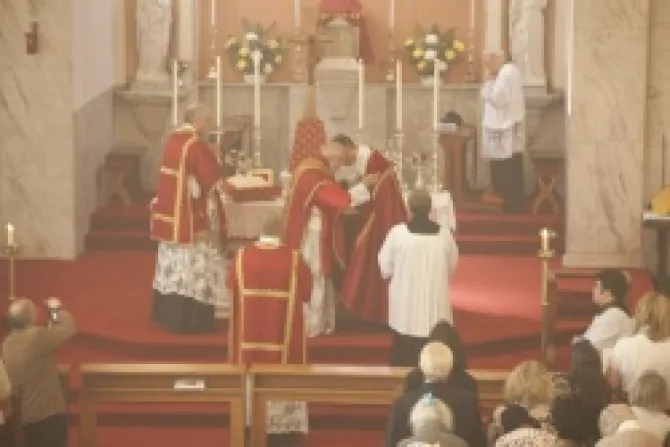Vatican City, Jul 31, 2014 / 16:01 pm
The Congregation for Divine Worship, in a recent circular letter, announced that the placement of the sign of peace within Mass will not change, though it suggested several ways the rite could be performed with greater dignity.
"The Congregation for Divine Worship and the Discipline of the Sacraments … pronounced in favor of maintaining the 'rite' and 'sign' of peace in the place it has now in the Ordinary of the Mass," Fr. Jose Maria Gil Tamayo, secretary general of the Spanish bishops' conference, related in a July 28 memo.
He noted that this was done out of consideration of the placement of the rite of peace as "a characteristic of the Roman rite," and "not believing it to be suitable for the faithful to introduce structural changes in the Eucharistic Celebration, at this time."
The sign of peace is made after the consecration and just prior to the reception of Communion; it had been suggested that it be moved so that it would precede the presentation of the gifts.
Fr. Gil's memo was sent to the Spanish bishops, and prefaced the Congregation for Divine Worship's circular letter, which was signed June 8 by Cardinal Antonio Canizares Llovera, its prefect, and its secretary, Archbishop Arthur Roche. The circular had been approved and confirmed the previous day by Pope Francis.
The letter made four concrete suggestions about how the dignity of the sign of peace could be maintained against abuses.
Fr. Gil explained that the circular letter is a fruit of the 2005 synod of bishops on the Eucharist, in which the possibility of moving the rite was discussed.
"During the Synod of Bishops there was discussion about the appropriateness of greater restraint in this gesture, which can be exaggerated and cause a certain distraction in the assembly just before the reception of Communion," Benedict XVI wrote in his post-synodal apostolic exhortation 'Sacramentum caritatis'.
He added that "I have asked the competent curial offices to study the possibility of moving the sign of peace to another place, such as before the presentation of the gifts at the altar … taking into account ancient and venerable customs and the wishes expressed by the Synod Fathers."
An inspiration for the suggested change was Christ's exhortation, at Mt. 5:23, that "if you remember that your brother has anything against you, leave your offering before the altar, and go be reconciled first." It would also have brought the Roman rite into conformity, in that respect, with the Ambrosian rite, celebrated in Milan.
The Neo-Catechumenal Way, a lay movement in the Church, has already displaced the sign of peace, in its celebration of the Roman rite, to before the presentation of the gifts.
The Vatican congregation's decision to maintain the placement of the sign of peace was the fruit of dialogue with the world's bishops, which began in 2008, and in consultation with both Benedict XVI and Pope Francis.
The Congregation for Divine Worship said it would "offer some practical measures to better express the meaning of the sign of peace and to moderate excesses, which create confusion in the liturgical assembly just prior to Communion."
"If the faithful do not understand and do not show, in their ritual gestures, the true significance of the right of peace, they are weakened in the Christian concept of peace, and their fruitful participation in the Eucharist is negatively affected."
On this basis, the congregation offered four suggestions which are to form the "nucleus" of catechesis on the sign of peace.
First, while confirming the importance of the rite, it emphasized that "it is completely legitimate to affirm that it is not necessary to invite 'mechanistically' to exchange (the sign of) peace." The rite is optional, the congregation reminded, and there certainly are times and places where it is not fitting.
Its second recommendation was that as translations are made of the third typical edition of the Roman Missal, bishops' conference should consider "changing the way in which the exchange of peace is made." It suggested in particular that "familiar and worldly gestures of greeting" should be substituted with "other, more appropriate gestures."
The congregation for worship also noted that there are several abuses of the rite which are to be stopped: the introduction of a "song of peace," which does not exist in the Roman rite; the faithful moving from their place to exchange the sign; the priest leaving the altar to exchange the sign with the faithful; and when, at occasions such as weddings or funerals, it becomes an occasion for congratulations or condolences.
The Congregation for Divine Worship's final exhortation was that episcopal conferences prepare liturgical catechesis on the significance of the rite of peace, and its correct observation.
"The intimate relation between 'lex orandi' and 'lex credendi' should obviously be extended to 'lex vivendi'," the congregation's letter concluded.
"That Catholics are today faced with the grave commitment to build a more just and peaceful world, implies a more profound understanding of the Christian meaning of peace and of its expression in liturgical celebration."


